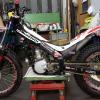-
Posts
979 -
Joined
-
Last visited
-
I have an older model Alpina motor and a couple of Sherpa's and had Bultaco's in the 70's, but I have not seen a stator like this one before. Usually the points are in the 10 O'clock position where you can see when they open through the slots in the flywheel. On the Sherpa's, the black wire is the low tension lead for the HT coil, and where the condensor hooks into. Green is the earth and yellow the power lead for lights and horn. To ID the LT coil, follow the wire back from the points to a coil. Bye, Peter B.
-
The crank case bearing housing may be out of round. Check the ID with a telescopic gauge and micrometer across two axis to determine this, or take the case to a machine shop for checking, and if out of round they may be able to machine such that the ID is true. I don't know what the ID would be, but imagine it can't be any more than a thou or two less than the bearing OD. Would be unusual for the bearing housing to be machined out of round, so if it is out of round, something must have caused this. A possibility could be that the chain came off at the gearbox sprocket and jammed up there, perhaps warping the crankcase at the secondary shaft. I know it's remote but, try removing the secondary output bearing next to the one you are trying to replace and see if there is a change in the 6002 bearing fit. Also, what do you mean when you can measure 1mm difference across the bearing? Where is this measurement taken. Bye, Peter B.
-
Are you sure it is a PHBH26 that you want? Pretty sure that a 300 Pro would have used a PHBL26 carb. The main difference is in the pilot passage ways, the PHBL works on the fuel passage way, with the adjusting screw closer to the reed block side, the PHBH works on the air with the adjusting screw located toward the back of the carb.
-
Those 40mm Marzocchi forks are a cartridge type, the cartridge is filled with oil and the air bled out. Best to leave the original oil in there, there is not that much and chances are that the oil in there is still in good order. Bleeding those cartridges takes a long time, unless very lucky. You can use 7.5W fork oil, look on the net for how to set up the oil quantity, The Hell Team have a good video covering this. "W" stands for winter, not weight. Bye, Peter B.
-
Check to see there is a retaining screw (with a vent hole drilled through the centre) plus centering collar holding the clutch centre in place. Bye, Peter B.
-
Those flywheels are on real tight, when you make the puller (I used a flange with 3 x M8 socket head bolts with a threaded insert), make sure the bolts go a long way into the flywheel, get a lot of tension on and tap/smack the end of the centre extracting bolt head to break loose the taper. On the older motors, there are no pressure fed bearings, just gravity fed from the gearbox. Check the LHS crank bearing has not failed, you would have heard a rumble by now if it was.
-
I don't know what that upgrade kit is, but I have seen Trials Bike Breakers advertise a replacement kit for the Ducati ign systems, they may have some Ducati ign parts too. Bye, Peter B.
-
On those earlier Vertigo's, there is little mating surface in the crank case area and quite easy for a few big knocks to jolt the two halves and create a leak path. If that is the case and the crankshaft seal has worn then you could be drawing in gearbox oil. You can leave the motor in the frame, turn the bike upside down, remove the clutch and strip off the lower crank case "half" We used Loctite Greymaxx as the sealant. Also need to bung up the vent in the fuel cap. Bye, Peter B.
-
It is possible that the motor is drawing in gearbox oil, possibly through the crankcase LHS. There may also be signs of gearbox oil escaping externally, have a look behind the flywheel.
-
I haven't worked on one of the older GG motors for many years, I don't think the crank shaft tapers are the same between the two models but would be worth checking out first. Pretty sure 1994 had Motoplat, 95/96 with the early Ducati system and 98 with the early Kokusan system. Bye, Peter B.
-
A common problem with the Ducati ign system is the voltage regulator failing. This is the aluminium finned unit. Underneath this, the electronics are potted with a green looking mix. When the regulator fails, a component burns out and discolours the potting, have a look to see if there is a brown discolouration, failure is from the component overheating. I have had one of the failed units in the oven to soften the potting mix to dig around the components to see what had failed but never managed a conclusion. Try some of the UK bike wreckers for a complete, used Kokusan system, from 2002 upwards.
-
I use a standard exhaust, there is no connection with the front stay or mudguard on full compression.
-
There is sufficient mudguard clearance to the frame, but you need to make up a new rear facing front guard stay. The original rear facing stay is 200mm from the top of the loop centre, to the centreline of the stanchions. The loop of the stay I use is 130mm from the stanchion centreline, and neither the stay nor the mudguard foul the frame on full compression. Was a good question by the way.
-
I use Alpina yokes on my Sherpa, steering angle is tighter, bars further forward and feels more like a modern bike. The stanchion width between centres is a little more than the Sherpa set up.










